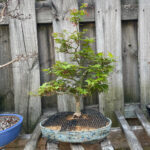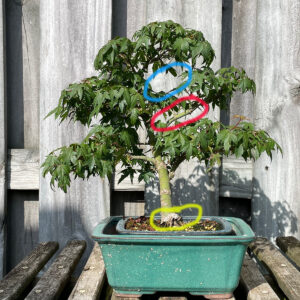Maple 07
Acer Palmatum ‘Kiyohime’
APRIL 2, 2025. Repotted last month, again one of the earliest to come out of dormancy. This time it’s in a newly acquired Shawn Bokeno pot I bought this year on the Facebook auctions. I’ve gone back to the front Doug recommended earlier. I sliced back part of the first branch to show more of the trunk — no big deal. And I’m continuing the extension upward. This time I’m keeping moist moss around the base, in the hope of encouraging some new root growth. Whatever. I do like the little tree, and it looks better every year. To me, at least.
MARCH 1, 2024. Once again, the Kiyohimes were at the forefront of leafing out, so this one was repotted a couple of weeks ago. This time it’s in the Michael Thiedeman pot instead of Byron’s pot. I like the glaze, and it’s virtually the same size as Byron’s. I made a few adjustments in my front, and I think it looks better. I don’t have the full width of the base that Doug suggested, but it does have more spread than before. Compromise is fun. I also wired out the leader (see below) and that might be the eventual apex of the tree in the end.
MARCH 19, 2023. Strangely enough, this year my two kiyohimes leafed out even earlier than my two elm trees. I have no idea why, of course, but the crazy early hard freeze in December might have affected all our plant growth this year. Anyway, this one was budding out early so I took it to the February workshop at Aldridge Gardens. I asked Doug for help and he told me to look at it from the ground up. I knew that already, to be sure, but hearing him talk about it made me actually do it! (Refer to my paragraph on the green background on the page/link that got you here.)
In the end I reoriented the tree when I repotted it this year, and I can already see that the little spike Doug pointed out will actually become the new leader. I’m glad I’m starting to listen to others about these things!
October 30, 2022. Once again, I’m disappointed in the root situation. In the spring I put this one in the Byron Myrick oval in Brussel’s soil. I think I have to move it back to a deeper pot next year and try again to get something to sprout higher up the little triangle of rootish material at the base of the trunk. I was also disappointed in the top growth. I expected some of the stuff you see in the 2021 photo to produce some upward growth, but that didn’t happen. The little branch I wired upward almost died, in fact. The truth is, this one doesn’t deserve a photo this year.
July 13, 2021. I’m a little behind in making notes on this one. I had hoped for roots all the way around, but all I got was a few new roots on one side. I was pissed a little, and decided it didn’t deserve another chance. But I relented and decided to just cut off all the original lower roots, put the poor little thing in a deeper pot than I would want, use Brussel’s soil, and just hope for the best.
I was surprised a month or so later to discover that the pitifully few new roots were thriving. the tree actually looks better than ever. The problems that still remain are these:
- I need to keep working on the roots, especially where new ones haven’t sprouted yet. Left as you look at it from the front. Marked in yellow.
- The second branch on the right is a stick for a couple of inches. I might not get any secondary branches there, but I might be able to cover the problem up with a little careful wiring. Marked in red.
- I need to do something about the hole on the right in the front view. Ugly. Marked in blue.
the unedited photo is below.
 2020. February 24. I got this one repotted in a deeper container, and I hope I’m doing the right thing trying to get a better nebari. I pruned roots way back, and I made some horizontal notches along the awkward looking spread above the root flare. I put some rooting powder on this notches, but that might not work. Like in the case of the Chinese hackberry, I don’t think I put enough potting medium around those notches, and I’m pretty sure I didn’t leave enough pressure around those places to do any good. So I’ll have to go back and redo that part. And I’ll have to do it it soon if it’s going to do any good. The encouraging thing is that the tree looks pretty damned good if you don’t look at the roots! UPDATE. Photo from April 10.
2020. February 24. I got this one repotted in a deeper container, and I hope I’m doing the right thing trying to get a better nebari. I pruned roots way back, and I made some horizontal notches along the awkward looking spread above the root flare. I put some rooting powder on this notches, but that might not work. Like in the case of the Chinese hackberry, I don’t think I put enough potting medium around those notches, and I’m pretty sure I didn’t leave enough pressure around those places to do any good. So I’ll have to go back and redo that part. And I’ll have to do it it soon if it’s going to do any good. The encouraging thing is that the tree looks pretty damned good if you don’t look at the roots! UPDATE. Photo from April 10.
 2018. March 12. The tree is doing well, and I think at this point it looks better than the other one, which was so much healthier looking last year. The only real problem I have with this one is its nebari/root flare. It’s two-dimensional and chicken-footy. But I’m happy with the way the foliage is progressing, and I’m trying to stay on top of it to combat legginess in the new growth. I just hope I doing it right! I like this photo with the little seedling as a “companion” plant.
2018. March 12. The tree is doing well, and I think at this point it looks better than the other one, which was so much healthier looking last year. The only real problem I have with this one is its nebari/root flare. It’s two-dimensional and chicken-footy. But I’m happy with the way the foliage is progressing, and I’m trying to stay on top of it to combat legginess in the new growth. I just hope I doing it right! I like this photo with the little seedling as a “companion” plant.
2018.February 9. I’ve not kept this page up, I’m afraid. And it’s time to give each one a separate page anyway, so here goes. This page once described both trees, now it describes only one of them. See below for history. The good thing is that they both recovered from what I thought was a problem with fungus. I had just let them dry out a little too much too soon. They were looking a bit used up but OK when dormancy hit in the fall.
This one isn’t as far along as the other one. In fact, it’s been a little weaker looking, lighter colored foliage, funny nebari, etc. since I got it. I’ll pot it up in a plain ceramic pot when it shows a little more interest in opening up for the season.
Older notes:
2017. July. One of these might have the fungus! I’ve got leaves turning funny-colored and dropping. I’ll have to get more Daconil fast. Or use the mix of the triple threat one. We’ve had way too much rain for this time of year, and that’s affecting everything. I’ll blame it on that for now.
 2017.04.11. I bought these from Leo Wagner last night at the ABS meeting. Truth in reporting statement: I’ve killed two of these before. I’m going to be more careful this time, I promise.
2017.04.11. I bought these from Leo Wagner last night at the ABS meeting. Truth in reporting statement: I’ve killed two of these before. I’m going to be more careful this time, I promise.
One of these has a trunk line that sweeps to one side, so I’m slating it for the tree modeled on the dogwood at the entrance to the Dunbarton houses. I’ll find a photo somewhere.









